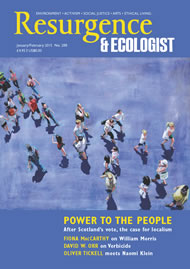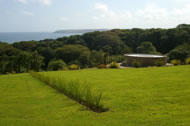Initially everything appears very low-key. You come in through a beautifully landscaped car park and see a wooden visitors’ centre and café nestled into the slope, and a discreet nursery for selling plants. Having bought your ticket you go through a back door into a shaded lane. A stream becomes ever noisier on your right as you walk along a modest track, which seems not to promise very much but then unveils itself in a beguiling way. As it opens up, the first of many viewing areas lets you glimpse a pond and you begin to see the lush planting. The lane continues, over a bridge, round a corner – a pilgrimage.
The pathway unfolds along raised boardwalks amidst huge ferns, mossy trunks of fallen trees, and large-leaved rhododendrons, always with the sound of water nearby and the high tree canopy above. It opens into viewpoints with seats looking down on the top of palm leaves and fern fronds over the water, while intriguing trails lead off into leafy shadows. Always there seem to be at least two options: a path up, or a path down or around. Climbing up the valley, a flight of steps opens up into a more spacious garden of stone-walled beds and more arid planting. The lushness of water and ferns of the lower valley gives way to crocosmia, day lilies, succulents and grasses, taking you from Cornwall or New Zealand to the Mediterranean, South Africa or Mexico. Suddenly the view opens out over the tops of the trees up the valley you have climbed and you see St Michael’s Mount like a mandala, sitting out to sea.
Up here is James Turrell’s skyspace installation. You enter through a dark tunnel reminiscent of early chamber tombs into a brilliant white open space looking up into the sky and clouds framed in the oval opening. Time and light expand.
Higher again, you find a meadow with a work in progress by Richard Long, a sculptural line made by grasses growing. From here, one path leads through wild woods to a quietly dramatic collection of charred wood sculptures by David Nash, like black-cloaked pilgrims. Not far away, the only figurative piece in the garden, a great minotaur of darkened bronze with huge horns, looms out of a grove of trees above a path.
Talking to Tremenheere’s creator, Neil Armstrong, I learn that the first inspiration was the land with its mature woodland, south-facing aspect, stream, very good soil and microclimate. He describes it as “a guardian landscape that draws you in and then has these amazing vistas, but it’s primarily the way it keeps itself discreetly hidden”. My sense of pilgrimage is not wrong. The site hosts one of the pilgrim routes to Santiago de Compostela. It was here that monks from Wales, Ireland and Scotland came centuries ago, after sailing into St Ives and crossing the peninsula to pray at St Michael’s Mount.
The garden you see today is Armstrong’s single vision, planned around the central trinity of landscape, art and planting. His is a very specific concept: these three major components all have to earn their keep independently of each other and they all have to interact with each other so that none of them becomes dominant. While the horticultural element is of enormous interest, with collections of evergreen magnolias, Schefflera, and the largest UK collection of grass trees, Xanthorrhoea glauca, the complex layering of plants is above all architectural and sculptural. There are no labels or signs, for this would offend the aim of keeping a naturalistic feel. Armstrong’s main intention is to try to create a place of tranquillity and inspiration, “a spiritual place with meditative and restorative qualities and everything else must be stage players to get to that place. When you label something it becomes a different thing, a museum, a botanic garden.”
Tremenheere is not a botanic garden or a museum, but an evolving and living experience. The skyspace has taken 15 years to come to fruition, starting initially as a temporary space during the solar eclipse of 1999. There is also another Turrell light-projection work, which is occasionally available for visits. A polar opposite of the skyspace, Aqua Obscura is underground and dark in an old Victorian water-settling tank, and exploits the way your brain recalibrates itself from light to darkness. It takes minutes to be able to see a projection of sky and treetops where initially there was only deep velvet blackness. Up the hill, In contrast with this underground camera obscura, local artist Billy Wynter has installed a more conventional yet no less magical one in its own circular building. Overall, the allusion of the artworks is simplicity, contemplation and deep time, perhaps exemplified by Kishio Suga’s installation of a line of logs slowly rotting back into the earth, yet still a statement, a barrier, just like Richard Long’s emerging line of grasses.
Though Armstrong is still working full time as a GP, there are many plans for the future of the gardens: new sculptures, new events, another four acres of grassy prairie planting, a new quarry space. Armstrong’s particular vision, supported by an involved and friendly group of staff, imbues everything. The planting, the artwork, the excellent café, shop and plant nursery, and even the design of the benches, reflect the same exceptional standard. Tremenheere is an enormously welcome and unique addition to the gardens of Cornwall – indeed, of the UK.
For more information on the gardens visit www.tremenheere.co.uk








